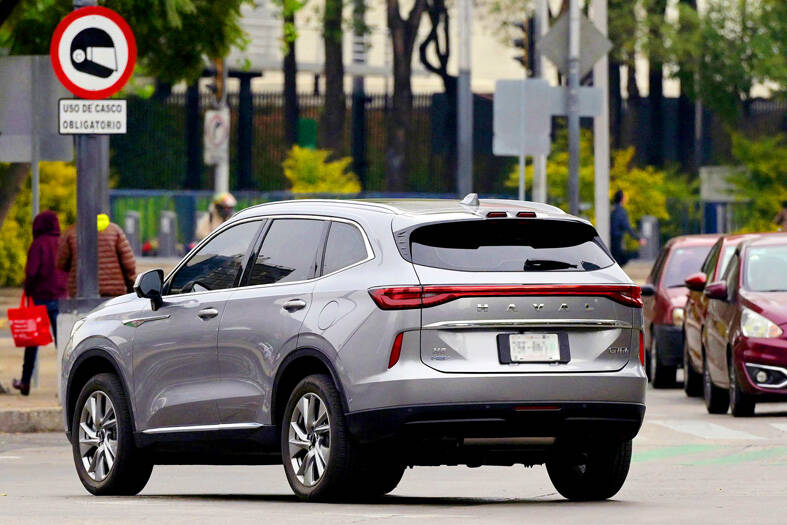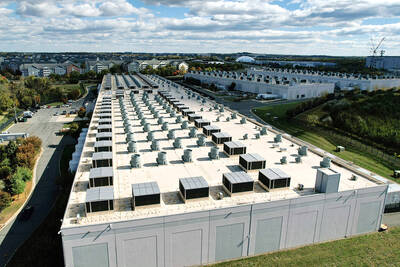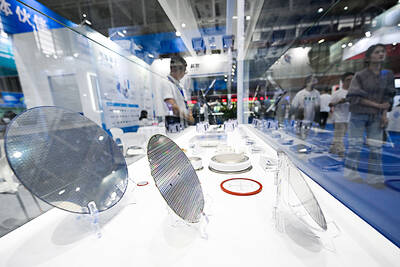The growing popularity of Chinese sport utility vehicles and pickup trucks has shaken up Mexico’s luxury car market, hitting sales of traditionally dominant brands such as Mercedes-Benz and BMW.
Mexicans are increasingly switching from traditionally dominant sedans to Chinese vehicles due to a combination of comfort, technology and price, industry experts say.
It is no small feat in a country home to factories of foreign brands such as Audi and BMW, and where until a few years ago imported Chinese cars were stigmatized, as in other parts of the world.

Photo: AFP
The high-end segment of the market registered a sales drop of 8.1 percent from January to last month, the Mexican Association of Automotive Distributors (AMDA) said.
Audi’s sales slumped by 21.9 percent, while BMW, which includes the Mini brand, saw no growth in Latin America’s second-largest economy, home to 129 million people.
Mercedes-Benz had a 9.8 percent decline, according to the state-run statistics institute INEGI.
In contrast, Motornation, which sells the Beijing Automotive Industry Corp (BAIC, 北京汽車工業), JMC (江鈴汽車) and Changan (重慶長安汽車) brands in Mexico, saw an 8.8 percent increase in sales in the first 11 months of this year, while those of Jetour (捷途汽車) rose 131 percent, it said.
Chinese firms now control 9.3 percent of the Mexican market, according to the AMDA.
They have brought stiff competition to the pickup truck segment, with many of the features of high-end models offered by premium brands, association president Guillermo Rosales said.
Traditionally, the premium segment included sedan-type vehicles with luxury engines and top-of-the-range features.
However, over the past decade consumer preferences have shifted toward utility vehicles such as pickup trucks, minivans and SUVs.
Asian brands also benefited from an exemption from import tariffs on electric vehicles that was in effect in Mexico from 2020 until Oct. 1.
As in other Latin American countries, Mexicans are becoming more used to seeing Chinese brands on the streets that were unknown to them until about five years ago.
Miguel Reyes, a 71-year-old retiree, said that choosing a Chinese car over others was “simple arithmetic.”
“I needed a car that had the necessary technology, such as steering assist, to make driving safer,” Reyes said.
As well as the design and comfort, the “competitive” price was another factor, said Reyes, who paid about 550,000 pesos (US$27,057).
A similar model from a traditional brand would have cost him US$40,000 to US$50,000, he said.
There are about 30 Chinese brands in Mexico, with vehicles ranging from compacts to luxury cars, said Gerardo Gomez, an expert at the data and analytics company J.D. Power.
“They can offer you anything at any point in the range,” Gomez said.
BYD (比亞迪) offers an electric pickup truck for more than 1 million pesos, but also a compact car for US$17,000.
Zeekr (極氪智能), a premium electric brand, sells luxury models for about US$40,000.
Chinese cars’ growing presence in Mexico, which is itself a major exporter of vehicles, comes at a time when China is a source of contention between the US, Mexico and Canada, partners in a regional free trade agreement.
During his campaign, US president-elect Donald Trump suggested that China was building car factories in Mexico to sell vehicles in the US.
Canadian officials have accused Mexico of being a springboard for Chinese products in the region — a claim denied by Mexican authorities.
Trump has also threatened to impose 25 percent tariffs on Mexico and Canada unless they stop flows of migrants and drugs.
Only 7 percent of the components of cars manufactured in the Latin American country are Chinese, Mexican President Claudia Sheinbaum said.
“There’s no evidence from anywhere that proves that Mexico is being used as a springboard” for Chinese products, said Diego Marroquin, a trade policy specialist at the Wilson Center in the US.
“It’s a political narrative that comes from the United States and now from Canada,” Marroquin said.
Sheinbaum last month said that she would propose to the US and Canada a Chinese import substitution plan, adding that in the case of Mexico alone, the trade deficit with the Asian giant amounted to US$80 billion.

The demise of the coal industry left the US’ Appalachian region in tatters, with lost jobs, spoiled water and countless kilometers of abandoned underground mines. Now entrepreneurs are eyeing the rural region with ambitious visions to rebuild its economy by converting old mines into solar power systems and data centers that could help fuel the increasing power demands of the artificial intelligence (AI) boom. One such project is underway by a non-profit team calling itself Energy DELTA (Discovery, Education, Learning and Technology Accelerator) Lab, which is looking to develop energy sources on about 26,305 hectares of old coal land in

Taiwan’s exports soared 56 percent year-on-year to an all-time high of US$64.05 billion last month, propelled by surging global demand for artificial intelligence (AI), high-performance computing and cloud service infrastructure, the Ministry of Finance said yesterday. Department of Statistics Director-General Beatrice Tsai (蔡美娜) called the figure an unexpected upside surprise, citing a wave of technology orders from overseas customers alongside the usual year-end shopping season for technology products. Growth is likely to remain strong this month, she said, projecting a 40 percent to 45 percent expansion on an annual basis. The outperformance could prompt the Directorate-General of Budget, Accounting and

Netflix on Friday faced fierce criticism over its blockbuster deal to acquire Warner Bros Discovery. The streaming giant is already viewed as a pariah in some Hollywood circles, largely due to its reluctance to release content in theaters and its disruption of traditional industry practices. As Netflix emerged as the likely winning bidder for Warner Bros — the studio behind Casablanca, the Harry Potter movies and Friends — Hollywood’s elite launched an aggressive campaign against the acquisition. Titanic director James Cameron called the buyout a “disaster,” while a group of prominent producers are lobbying US Congress to oppose the deal,

Two Chinese chipmakers are attracting strong retail investor demand, buoyed by industry peer Moore Threads Technology Co’s (摩爾線程) stellar debut. The retail portion of MetaX Integrated Circuits (Shanghai) Co’s (上海沐曦) upcoming initial public offering (IPO) was 2,986 times oversubscribed on Friday, according to a filing. Meanwhile, Beijing Onmicro Electronics Co (北京昂瑞微), which makes radio frequency chips, was 2,899 times oversubscribed on Friday, its filing showed. The bids coincided with Moore Threads’ trading debut, which surged 425 percent on Friday after raising 8 billion yuan (US$1.13 billion) on bets that the company could emerge as a viable local competitor to Nvidia